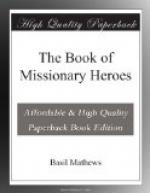But Shomolekae desired always to go further and further, even though it was dangerous and difficult. So he got a canoe and launched it in the river by the village and paddled further and further up the stream, under the overhanging trees, and sometimes across the deep pools in which the big and fierce hippopotami and crocodiles lived.
He paddled up the River Okanvango, though many times he was in danger of his life. The river was not like rivers in our own country, deep and with strong banks; it was often filled all over with reeds, and as shallow as a swamp, and poor Shomolekae had to push his way with difficulty through these reeds. Always at night the poisonous mosquitoes came buzzing and humming around him. The evil-tempered hippopotamus would suddenly come up from the bottom of the river with his wicked beady eyes, and great cavernous mouth, with its enormous teeth, yawning at Shomolekae as though he quite meant to swallow him whole.
On the banks at night the lions would roar, and then the hyenas would howl; but Shomolekae’s brave heart held on, and he pushed on up the river to preach and teach the people in the villages near the river.
So through many years, with high courage and simple faith, Shomolekae worked.
A good many boys and girls in England before they are ten years old own many more books than Shomolekae ever had and have read more than he. They also have better homes than he, for he pushed on from one mud hut to another along the rivers and lakes, and all the possessions that he had in the world could be put into the bottom of his canoe.
But our Heavenly Father, Who loves you and me, went with him every step of the way. When Shomolekae taught the boys and girls to sing hymns in praise of Jesus, even in a little mud hut, He was there, just as He is in the most beautiful church when we worship Him. Now God has taken Shomolekae across the last river to be with Himself.
Shomolekae was a negro with dark skin and curly hair. We are white children with fair faces and light hair. But God is his Father as well as ours and loves us all alike and wishes to gather us together round Him—loving Him and one another.
FOOTNOTES:
[Footnote 56: Pronounce Shoh-moh-leh-kei.]
CHAPTER XXII
THE WOMAN WHO CONQUERED CANNIBALS
Mary Slessor
(Dates, b. 1848, d. 1915)
I. THE MILL-GIRL
The Calabar Girls at the Station
As the train from the south slowed down in Waverley Station, Edinburgh, one day in 1898, a black face, with eyes wide open with wonder, appeared at the window. The carriage door opened and a little African girl was handed down onto the platform.
The people on the station stopped to glance at the strange negro face. But as a second African girl a little older than the first stepped from the carriage to the platform, and a third, and then a fourth black girl appeared, the cabmen and porters stood staring in amused curiosity.




